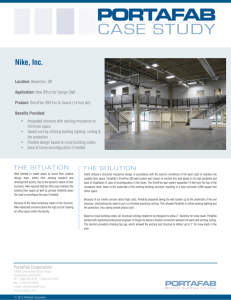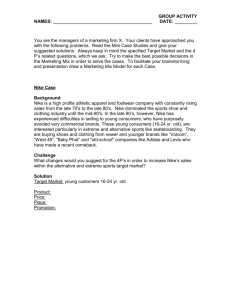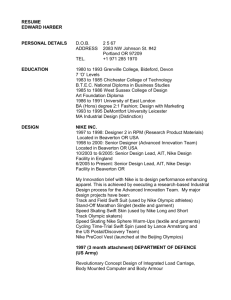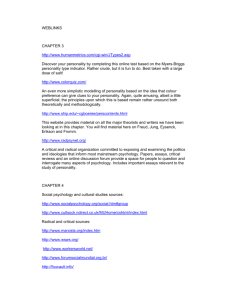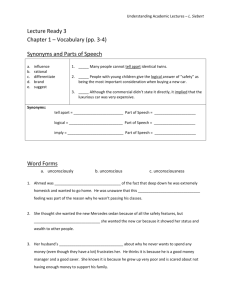The 4 Minute Guide to Nike's Investment Plans
advertisement
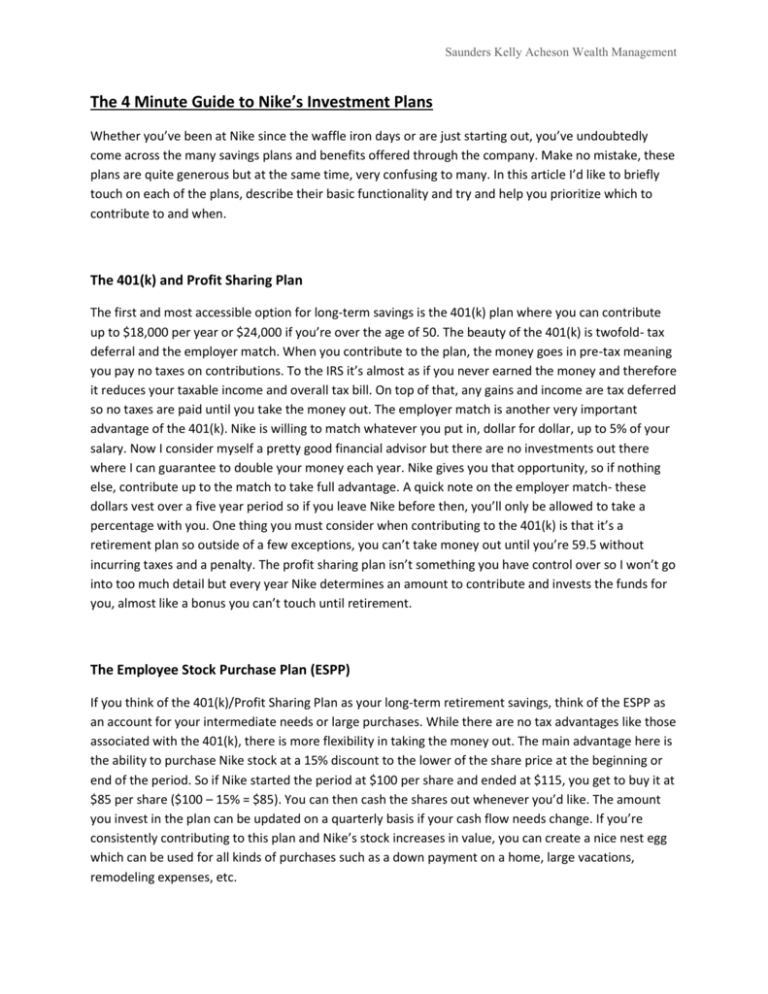
Saunders Kelly Acheson Wealth Management The 4 Minute Guide to Nike’s Investment Plans Whether you’ve been at Nike since the waffle iron days or are just starting out, you’ve undoubtedly come across the many savings plans and benefits offered through the company. Make no mistake, these plans are quite generous but at the same time, very confusing to many. In this article I’d like to briefly touch on each of the plans, describe their basic functionality and try and help you prioritize which to contribute to and when. The 401(k) and Profit Sharing Plan The first and most accessible option for long-term savings is the 401(k) plan where you can contribute up to $18,000 per year or $24,000 if you’re over the age of 50. The beauty of the 401(k) is twofold- tax deferral and the employer match. When you contribute to the plan, the money goes in pre-tax meaning you pay no taxes on contributions. To the IRS it’s almost as if you never earned the money and therefore it reduces your taxable income and overall tax bill. On top of that, any gains and income are tax deferred so no taxes are paid until you take the money out. The employer match is another very important advantage of the 401(k). Nike is willing to match whatever you put in, dollar for dollar, up to 5% of your salary. Now I consider myself a pretty good financial advisor but there are no investments out there where I can guarantee to double your money each year. Nike gives you that opportunity, so if nothing else, contribute up to the match to take full advantage. A quick note on the employer match- these dollars vest over a five year period so if you leave Nike before then, you’ll only be allowed to take a percentage with you. One thing you must consider when contributing to the 401(k) is that it’s a retirement plan so outside of a few exceptions, you can’t take money out until you’re 59.5 without incurring taxes and a penalty. The profit sharing plan isn’t something you have control over so I won’t go into too much detail but every year Nike determines an amount to contribute and invests the funds for you, almost like a bonus you can’t touch until retirement. The Employee Stock Purchase Plan (ESPP) If you think of the 401(k)/Profit Sharing Plan as your long-term retirement savings, think of the ESPP as an account for your intermediate needs or large purchases. While there are no tax advantages like those associated with the 401(k), there is more flexibility in taking the money out. The main advantage here is the ability to purchase Nike stock at a 15% discount to the lower of the share price at the beginning or end of the period. So if Nike started the period at $100 per share and ended at $115, you get to buy it at $85 per share ($100 – 15% = $85). You can then cash the shares out whenever you’d like. The amount you invest in the plan can be updated on a quarterly basis if your cash flow needs change. If you’re consistently contributing to this plan and Nike’s stock increases in value, you can create a nice nest egg which can be used for all kinds of purchases such as a down payment on a home, large vacations, remodeling expenses, etc. Saunders Kelly Acheson Wealth Management Nike Stock Options At the E band level you will most likely begin receiving stock options. Unlike the 401(k) or ESPP, you will not be able to contribute to this plan or purchase stock options. Instead they are awarded based on your individual performance and the performance of Nike as a whole. Stock options are bit more complicated than the previously mentioned plans and there are a few key components you need to be aware of to understand how they work. The first number you want to look at is the “Quantity Exercisable” which indicates how many of your shares have vested. This is the number of shares that actually belong to you should you want to cash them out. The next number is the “Grant Price” which is the price per share you’re able to buy Nike stock at. When the options are issued they always come with a grant price and in order for them to have value, the current market price has to be higher than the grant price. The “Market Price” is quite simply the price Nike is currently trading at. The final column you want to pay attention to is the “Total Est Mkt Value” which takes the quantity of shares exercisable and multiplies it by the market price minus the grant price. Did I lose you yet? Ok let’s walk through a simple example to help clarify. Let’s say you have 2000 exercisable options with a grant price of $50 and the market price is $110. How much are these options worth? Subtract the grant price of $50 from the market price of $110 to give you $60. Multiply $60 by your 2,000 shares and you get a total value of $120,000. Vested stock options may be exercised anytime which gives you the ability to spend the money whenever you need it. There are tax and risk management issues that must be considered with stock options so it’s advisable to work with a financial planner and tax advisor to develop a strategy on when and what quantity should be exercised each year. The Deferred Compensation Plan The final plan we’ll discuss here is the Deferred Compensation Plan which is offered to employees earning an annual base salary of at least $150,000. If you’re under this mark then the following won’t apply to you just yet, but keep working and you’ll get there. For those of you making in excess of $150,000, this plan can be a valuable tool for reducing your tax bill. The deferred comp plan is the last of the options you want to contribute to and is designed to reduce the tax burden on any money you’re making that you really don’t need right now. It works like this- rather than receiving this money in your paycheck, you can have Nike place it off to the side for you in an account with various investment options. You then decide when you’d like the contribution to be paid out to you. This must be a minimum of four years down the road but can be extended much longer. Because you never really “receive” the money in the eyes of the IRS, you’re only responsible for paying the Social Security/Medicare tax while avoiding state and federal taxes. Ideally you structure the distributions for a time when your income is lower; hence you’re in a lower tax bracket and pay less on the distribution. Open enrollment is once a year in October/November and you can elect to defer between 1% and 100% of your eligible compensation. As always, consult with your tax and financial advisors before selecting any specific strategies involving the Deferred Compensation Plan. Saunders Kelly Acheson Wealth Management Hopefully this guide sheds some light on the various financial benefits offered through Nike and is written in a way that’s easy to understand. However, even my best attempts at clearly articulating my thoughts on financial matters can fall short so I’m always happy to answer questions or talk in more detail. Please feel free to call or email me using the contact information below. Best of luck! Kendall Acheson, CFP® 503-944-2341 Kendall.acheson@raymondjames.com www.skawealth.com Kendall is a wealth advisor and CERTIFIED FINANCIAL PLANNER™ professional with Saunders Kelly Acheson Wealth Management of Raymond James. He specializes in working with Nike employees helping them take control of and optimize their financial situation. His process focuses on creating, protecting, enhancing and distributing wealth. Certified Financial Planner Board of Standards Inc. owns the certification marks CFP® and CERTIFIED FINANCIAL PLANNER™ in the U.S., which it awards to individuals who successfully completed CFP Board’s initial and ongoing certification requirements.



